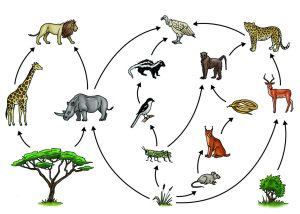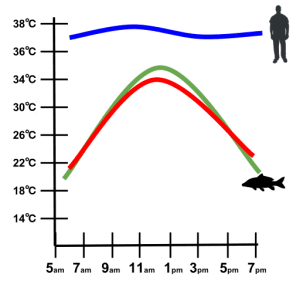
8.2 Energy Flow Through Ecosystems
All organisms in an ecosystem need energy. Remember, all the energy that we have on Earth originates from the sun. Photosynthetic organisms, like plants and bacteria, convert this solar energy into usable energy through photosynthesis. Energy flows through ecosystems, starting with energy from the sun, moving through photosynthetic organisms, and continuing to the organisms that consume them. The majority of energy is lost as heat between levels of the ecosystem, used by the individual for heat production, digestion, and other metabolic functions.
Trophic Levels
As energy flows through an ecosystem, it moves through different trophic levels. A trophic level represents the position of an organism in the food chain based on its source of energy. Autotrophs, such as plants, produce their own energy through photosynthesis. Heterotrophs, like animals, obtain energy by consuming other organisms. 🌱

The maintenance of energy levels is essential for the survival of all organisms. If an organism uses more energy than it consumes, it will experience a net loss of energy, potentially leading to weight loss and death. Conversely, an organism that gains more energy than it expends will have a net positive energy balance, allowing it to grow and store energy—critical for survival and reproduction.
Maintaining Energy
Organisms have evolved different strategies to maintain heat and energy within their bodies. ⚡
Endotherms maintain a constant body temperature. Humans are an example of endotherms, keeping their body temperature between 97 and 99°F. Endotherms use a significant portion of their energy to regulate internal temperature.
Ectotherms do not regulate their internal temperature. Reptiles and fish are ectotherms and must change their behavior, like hibernating in winter or basking in the sun during summer, to maintain an optimal temperature. Generally, smaller organisms have higher metabolic rates, meaning a mouse metabolizes energy more quickly than a human.
The availability of energy also determines the growth, population density, and overall health of ecosystems. Ecosystems with an abundance of producers are better equipped to sustain various species and maintain ecological stability.

Energy and Reproductive Strategies
Different organisms use various reproductive strategies in response to energy availability. For example, some organisms reproduce quickly and produce many offspring in a short period of time, maximizing their chances of passing on genes. This is known as an “r-selected” strategy. Other organisms, such as trees, reproduce more slowly and invest substantial energy into fewer offspring, maximizing each offspring’s chance of survival—a “K-selected” strategy. 🌲
There is also a relationship between metabolic rate per unit of body mass and the size of multicellular organisms. Generally, the smaller the organism, the higher its metabolic rate. This is because smaller organisms have a larger surface area relative to their volume, requiring more energy to maintain homeostasis.
A net gain in energy results in growth or energy storage, such as fat or glycogen, which can be used during periods of food scarcity. Conversely, a net loss of energy results in loss of mass and potentially death. 🥶
Potential Disruptions to Ecosystems
Changes in energy availability can cause disruptions in ecosystems. Energy drives all living systems, and fluctuations in energy resources can significantly affect ecosystem functioning. 😳
Sunlight Changes: A decrease in sunlight can reduce the productivity of primary producers, affecting all other trophic levels dependent on them. Conversely, an increase in sunlight boosts the productivity of primary producers, leading to population growth across multiple trophic levels.
Producer Changes: Changes in the abundance of producers impact herbivores and carnivores. A reduction in primary producers reduces the food supply for herbivores, leading to a decline in their population, which in turn affects the carnivores relying on them.
Changes in energy availability can also impact biodiversity and species distribution. For example, a shift in sunlight can alter which species thrive, leading to changes in the makeup of plant and animal communities. This cascade of changes highlights the interconnectedness of all species within an ecosystem, emphasizing the importance of stable energy flow for maintaining ecosystem health.
Recent Posts
- Laws of Indices – Number & Algebra – IB Mathematics AA HL
- Standard Form – Number & Algebra – IB Mathematics AA HL
- 9.2 Crafting an argument through stylistic choices like word choice and description
- 9.1 Strategically conceding, rebutting, or refuting information
- Unit 9 Overview: Developing a Complex Argument
- 8.4 Considering how style affects an argument
- 8.3 Considering how all choices made in an argument affect the audience
- 8.2 Considering how sentence development and word choice affect how the writer is perceived by an audience
- 8.1 Choosing comparisons based on an audience
- Unit 8 Overview: Stylistic Choices
- 7.4 Exploring how sentence development affects an argument
- Syllabus
- Study Guides for every class
- Short Notes
- 7.3 Examining how counterargument or alternative perspectives affect an argument
Choose Topic
- ACT (17)
- AP (20)
- AP Art and Design (5)
- AP Physics 1 (1)
- AQA (5)
- Artificial intelligence (AI) (2)
- Banking and Finance (6)
- Biology (13)
- Business Ideas (68)
- Calculator (72)
- ChatGPT (1)
- Chemistry (3)
- Colleges Rankings (48)
- Computer Science (4)
- Conversion Tools (136)
- Cosmetic Procedures (50)
- Cryptocurrency (49)
- Digital SAT (3)
- Edexcel (4)
- English (1)
- Environmental Science (2)
- Exam Updates (1)
- Finance (17)
- Fitness & Wellness (164)
- Free Learning Resources (209)
- GCSE (1)
- General Guides (40)
- Health (107)
- History and Social Sciences (152)
- IB (1)
- IGCSE (2)
- Image Converters (3)
- IMF (10)
- Math (39)
- Mental Health (58)
- News (8)
- OCR (3)
- Past Papers (463)
- Physics (5)
- SAT (39)
- Schools (3)
- Sciences (1)
- Short Notes (5)
- Study Guides (28)
- Syllabus (19)
- Tools (1)
- Tutoring (1)

